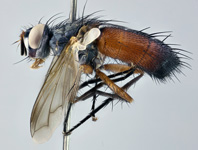Abstract
A new species of the genus Oecanthus Serville, 1831 from Reserva Natural Vale, state of Espírito Santo, Brazil is described. The new species differs from other of this genus in characteristics of the pseudepiphallus main lobe, endophallic sclerites, posterior median lobe of the metanotal gland and black spots on the femora and tibiae. The chromosome number is 2n=16+XY♂=18 and 2n=16+XX♀=18, and this complement present one pair of autosomes less than the other five cytological studied species.
References
Collins, N., van den Berghe, E. & Carson, L. (2014) Two new species of Neoxabea, three new species of Oecanthus, and documentation of two other species in Nicaragua (Orthoptera: Gryllidae: Oecanthinae). Transactions of the American Entomological Society, 140 (1), 163–184.
http://dx.doi.org/10.3157/061.140.0111Desutter, L. (1987) Structure et évolution du complexe phallique des Gryllidea (Orthoptères) et classification des genres Néotropicaux de Grylloidea. Première Partie. Annales de la Société Entomologique de France, 23, 213–239.
Desutter-Grandcolas, L. (2003) Phylogeny and the evolution of acoustic communication in extant Ensifera (Insecta, Orthoptera.). Zoologica Scripta, 32, 525–561.
http://dx.doi.org/10.1046/j.1463-6409.2003.00142.xEades, D.C., Otte, D., Cigliano, M.M. & Braun, H. (2016) Orthoptera Species File Online. Version 5.0/5.0. [Cited 12 March 2016] Available from: http://Orthoptera.SpeciesFile.org (Accessed 3 Oct. 2016)
Hewitt, G.M. (1979) Orthoptera: Grasshoppers and crickets. In: John, B. (Ed.), Animal Cytogenetics 3. Insecta I. Gebrüder-Borntraeger, Berlin-Stuttgart, 170 pp.
Johnson, H.H. (1931) Centrioles and other cytoplasmic components of the male germ cells of the Gryllidae. Zeitschrift für wissenschaftliche Zoologie, 140, 115–166.
Kitada, S. (1949) Preliminary notes on the chromosomes of Oecanthus indicus. Kromosomo, 5–6, 227–228.
Makino, S. (1932) An unequal pair of idiochromosomes in the tree cricket Oecanthus longicauda. Journal of the Faculty of Science, Hokkaido University, VI (2), 1–36.
Metrani, S. & Balakrishnan, R. (2005) The utility of song and morphological characters in delineating species boundaries among sympatric tree crickets of the genus Oecanthus (Orthoptera: Gryllidae: Oecanthinae): a numerical taxonomic approach. Journal of Orthoptera Research, Philadelphia, 14 (1), 1–16.
http://dx.doi.org/10.1665/1082-6467(2005)14[1:TUOSAM]2.0.CO;2Milach, E.M, Martins, L.P., Costa, M.K.M., Gottschalk, M.S. Oliveira, G.L. Redü, D.R., Neutzling, A.S., Dornelles, J.E.F., Vasconcellos, L.A. & Zefa, E. (2015) A new species of tree crickets Oecanthus (Orthoptera, Gryllidae, Oecanthinae) in tobacco plantation from Southern Brazil, with body color variation. Zootaxa, 4018 (2), 266–278.
http://dx.doi.org/10.11646/zootaxa.4018.2.6Ohmachi, F. (1927) Preliminary note on cytological studies on Gryllodea (Chromosome-numbers and sex-chromosomes of eighteen species.). Proceedings of the Imperial Academy, 3 (7), 451–56.
Ohmachi, F. (1935) A comparative study of chromosome complements in the Gryllodea in relation to taxonomy. Bulletin of the Miyazaki College of Agriculture and Forestry, 5, 1–48.
Rehn, J.A.G. (1917) On Orthoptera from the vicinity of Rio de Janeiro, Brazil. Transactions of the American Entomological Society (Philadelphia), 43 (1), pp. 131.
Toms, R.B. & Otte, D. (1988) New genera, species and records of East and South African tree crickets (Orthoptera: Gryllidae: Oecanthinae). Annals of the Transvaal Museum, 34, 469–521.
Walker, T.J. (1962) The taxonomy and calling songs of United States tree crickets (Orthoptera: Gryllidae: Oecanthinae). I. The genus Neoxabea and the niveus and varicornis groups of the genus Oecanthus. Annals of the Entomological Society of America, 55, 303–322.
http://dx.doi.org/10.1093/aesa/55.3.303Walker, T.J. (1963) The taxonomy and calling songs of United States tree crickets (Orthoptera: Gryllidae: Oecanthinae). II. The nigricornis group of the genus Oecanthus. Annals of the Entomological Society of America, 56, 772–789.
http://dx.doi.org/10.1093/aesa/56.6.772Walker, T.J. (1967) Revision of Oecanthinae (Orthoptera: Gryllidae) of America south of the United States. Annals of the Entomological Society of America, 60, 784–796.
http://dx.doi.org/10.1093/aesa/60.4.784White, M.J.D. & Morley, F.H.W. (1955) Effects of pericentric rearrangements on recombination in grasshopper chromosomes. Genetics, 40, 604–619.
White, M.J.D. (1978) Modes of Speciation. W.H. Freeman Ltd. 455p.
Zefa, E., Neutzling, A.S., Redü, D.R., Oliveira, G.L. & Martins, L.P. (2012) A new species of Oecanthus and Oecanthus lineolatus Saussure, 1897 from Southern Brazil: species description, including phallic sclerites, metanotal glands and calling song (Orthoptera: Gryllidae: Oecanthinae). Zootaxa, 3360, 53–67.

